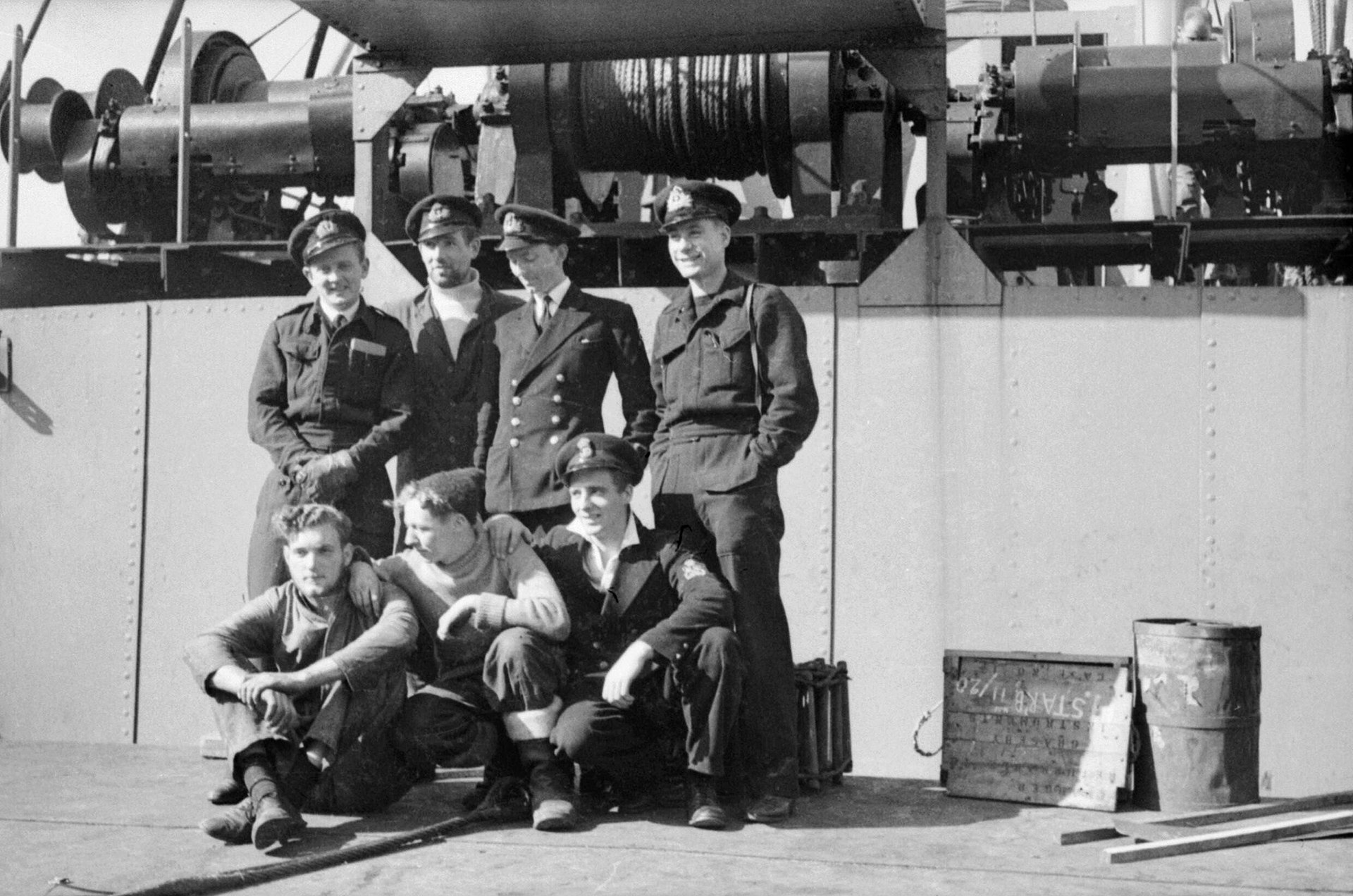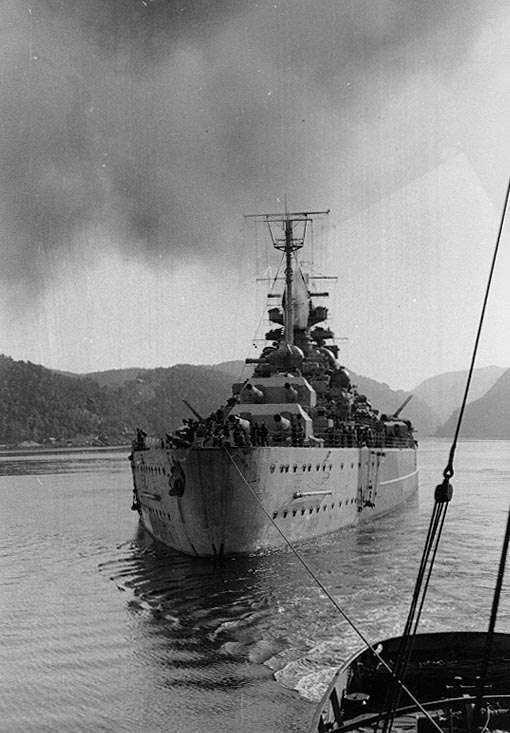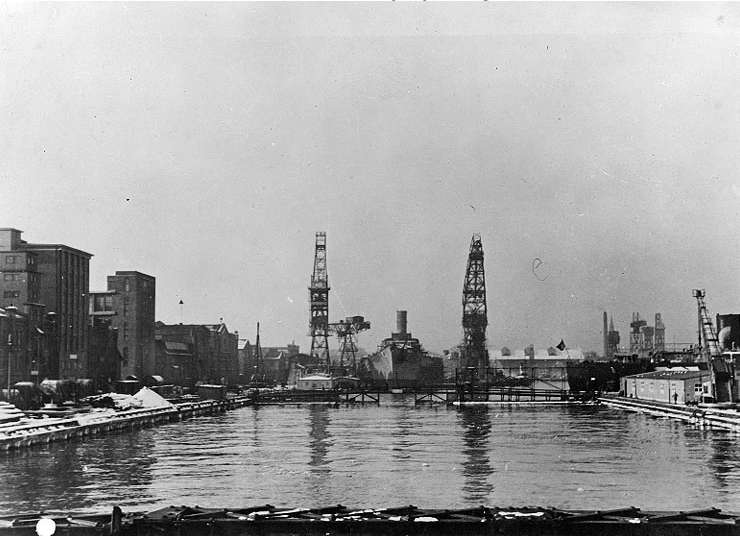
The Tirpitz Was Nearly Sunk by Midget Submarines
The German battleship Tirpitz, sister ship to the Bismarck, was a formidable naval threat during World War II, primarily stationed in Norwegian fjords to menace Allied convoys.
Advertisement
One of the most daring attempts to neutralize her was Operation Source in September 1943, where British X-class midget submarines successfully placed explosive charges beneath her hull, causing significant damage.
Despite this and several other attempts, it was not until Operation Catechism in November 1944 that the Tirpitz was finally sunk by RAF Lancaster bombers using Tallboy bombs.
The Tirpitz was laid down on November 2, 1936, at the Kriegsmarinewerft shipyard in Wilhelmshaven. Her construction was part of Germany’s broader naval rearmament program under the Treaty of Versailles’ restrictions. However, by the mid-1930s, Germany began openly flouting these restrictions, aiming to create a fleet capable of projecting power and challenging the naval dominance of the United Kingdom. The ship was launched on April 1, 1939, and after extensive fitting out and sea trials, she was commissioned into the Kriegsmarine on February 25, 1941.
Read More S-130 – The Last Remaining German E-Boat
The Tirpitz was a Bismarck-class battleship, designed to be one of the most formidable warships of her time. Her dimensions were impressive: she measured 251 meters (823.5 feet) in length, 36 meters (118.1 feet) in beam, and had a draft of 10.6 meters (34.8 feet). These dimensions made her one of the largest battleships ever built by Germany, comparable in size to the largest battleships of other major naval powers. The ship’s displacement was 42,900 tons standard, but when fully loaded, she could reach up to 52,600 tons.
 The battleship Tirpitz in Norwegian waters.
The battleship Tirpitz in Norwegian waters.The armament of the Tirpitz was one of her most notable features. Her primary battery consisted of eight 38 cm (15 inch) SK C/34 naval guns, mounted in four twin turrets. These guns had a maximum range of 36,520 meters (approximately 40,000 yards) and were capable of firing 800-kilogram (1,764-pound) armor-piercing shells, designed to penetrate the thick armor of enemy battleships.
The secondary armament included twelve 15 cm (5.9 inch) SK C/28 guns, intended for use against lighter ships and for shore bombardment. For anti-aircraft defense, the Tirpitz was initially equipped with sixteen 10.5 cm (4.1 inch) SK C/33 dual-purpose guns, sixteen 3.7 cm (1.5 inch) SK C/30 anti-aircraft guns, and twelve 2 cm (0.79 inch) Flak 38 anti-aircraft guns. As the war progressed and the threat from Allied aircraft increased, the number of 2 cm Flak 38 guns was increased to 58.
Read More That Time the USS Wisconsin Collided With a Destroyer
The Tirpitz’s armor scheme was designed to provide maximum protection against enemy shells and torpedoes. The main belt armor was up to 320 mm (12.6 inches) thick, providing a formidable barrier against enemy gunfire. The turrets, housing the primary armament, had armor up to 360 mm (14.2 inches) thick, making them resilient against direct hits. The deck armor, designed to protect against plunging fire and aerial bombs, was up to 120 mm (4.7 inches) thick. This comprehensive armor scheme was intended to allow the Tirpitz to withstand significant damage in battle, enabling her to continue fighting under heavy fire.
Advertisement
 The Tirpitz being fitted out in Wilhelmshaven, Germany, February 2 1940.
The Tirpitz being fitted out in Wilhelmshaven, Germany, February 2 1940.
In addition to her firepower and armor, the Tirpitz was equipped with advanced fire control systems and sensors for her time. These systems included rangefinders, radar, and other targeting equipment that allowed her to engage enemy ships accurately at long ranges. Her propulsion system consisted of twelve Wagner superheated boilers and three Blohm & Voss geared steam turbines, generating a total of 163,023 horsepower. This power enabled the Tirpitz to reach a top speed of 30.8 knots (57.0 km/h; 35.4 mph), making her one of the fastest battleships of her era.
Early Operational History
Upon her commissioning, the Tirpitz underwent extensive sea trials and training exercises to ready her for combat operations. These initial stages were critical, as they allowed the crew to familiarize themselves with the ship’s advanced systems and armament. Unlike her sister ship Bismarck, which embarked on a dramatic yet ill-fated maiden voyage resulting in her sinking, the Tirpitz’s operational history was marked by a series of strategic deployments rather than high-profile battles. Despite being equipped for direct confrontation, the Tirpitz spent much of her career as a strategic deterrent, a role that profoundly influenced Allied naval operations.
Read More That Time the Prinz Eugen Collided With the Light Cruiser Leipzig
In early 1942, the Tirpitz was relocated to Norway as part of Operation Cerberus, a move designed to extend German naval influence into the Arctic and threaten Allied convoys supplying the Soviet Union through the North Sea and Arctic Ocean. Norway’s rugged fjords provided natural fortifications that made it difficult for the Allies to launch effective attacks on the battleship. This strategic positioning in the fjords of Norway was aimed at leveraging the Tirpitz as a fleet in being—a powerful, potential threat that necessitated constant vigilance and the diversion of substantial Allied resources to monitor and counter her presence.
 The Tirpitz in a Norwegian fjord.
The Tirpitz in a Norwegian fjord.
The Tirpitz’s deployment to Norwegian waters aimed to disrupt Allied maritime logistics and deter any potential invasion of Norway. One of her primary roles was to intercept and destroy Allied Arctic convoys bound for the Soviet Union. However, the actual combat engagements of the Tirpitz were limited. One notable operation was Operation Rösselsprung in July 1942, an attempt to intercept and destroy Convoy PQ 17. Although the operation ultimately failed to bring the Tirpitz into direct combat with the convoy, the mere threat of her presence caused the convoy to scatter, leading to significant losses due to subsequent attacks by German U-boats and aircraft.
Another significant operation was Operation Sizilien in September 1943, during which the Tirpitz, along with the battleship Scharnhorst and other units, bombarded Allied positions on the island of Spitzbergen. This operation demonstrated the Tirpitz’s capability for shore bombardment and her role in supporting German operations in the Arctic. Despite these actions, the Tirpitz’s effectiveness was often curtailed by the constant threat of Allied air and submarine attacks, which necessitated frequent repairs and periods of inactivity.
Operation Source
The strategic threat posed by the Tirpitz, which was stationed in Norwegian waters, was a significant concern for the Allied forces. The battleship’s presence in the fjords meant that it could potentially break out into the North Atlantic, where it would pose a severe threat to Allied convoys supplying the Soviet Union and other critical routes. The decision to deploy midget submarines came from the realization that conventional attacks would be incredibly challenging due to the formidable defenses surrounding the Tirpitz.
Read More The Momsen Lung – A Development in Submarine Escape Technology
The X-class midget submarines, known as X-craft, were specifically designed for such covert operations. Each X-craft was around 15.5 meters (51 feet) long and could carry a crew of four. They were equipped with two large detachable explosive charges, known as side-cargoes, each containing two tons of amatol. These charges were intended to be placed beneath the target ship and detonated remotely after the crew had made their escape.
Advertisement
 A surviving X-Craft ‘X-24’ on display in Gosport, England. Image by Geni CC BY-SA 4.0
A surviving X-Craft ‘X-24’ on display in Gosport, England. Image by Geni CC BY-SA 4.0
Operation Source involved six X-craft: X5, X6, X7, X8, X9, and X10. They were towed by larger submarines to a position off the coast of Norway. From there, the X-craft would navigate independently through the complex and heavily defended fjords to reach their target.
On September 11, 1943, the towing operation commenced. However, the journey was fraught with difficulties. X8 developed mechanical issues and had to be scuttled. X9 was lost with all hands during the towing process. Despite these setbacks, the remaining X-craft continued toward their objective.
The attack on the Tirpitz took place on September 22, 1943. The X-craft faced numerous obstacles, including anti-submarine nets, mines, and patrol boats. The fjords were also heavily guarded by shore-based defenses and observation posts.
X6: Commanded by Lieutenant Donald Cameron, X6 successfully penetrated the anti-submarine nets and navigated through the obstacles. Despite being detected and coming under heavy fire, Cameron managed to get within a few meters of the Tirpitz and released both side-cargoes under the hull of the battleship. X6 was then scuttled, and Cameron and his crew were captured.
Read More Operation Tungsten – An Attempt To Sink The Tirpitz
X7: Commanded by Lieutenant Basil Place, X7 also managed to breach the defenses and approach the Tirpitz. However, the X-craft became entangled in a net and was heavily damaged by depth charges. Despite the damage, Place was able to release his side-cargoes. X7 was scuttled, and Place and his surviving crew members were captured.
X5: Commanded by Lieutenant Henty-Creer, X5’s fate is less clear. It is believed that X5 was detected and destroyed before it could place its charges, as it never returned and no survivors were captured.
 The crew of the X-5 (seen here). It is believed their craft was sunk by a direct hit from one of the Tirpitz’ 105 mm guns.
The crew of the X-5 (seen here). It is believed their craft was sunk by a direct hit from one of the Tirpitz’ 105 mm guns.
The explosive charges placed by X6 and X7 detonated as planned. The resulting explosions caused significant damage to the Tirpitz, including bending her propeller shafts, causing severe flooding, and putting several compartments out of action. Although the Tirpitz did not sink, the damage was extensive enough to render her immobile for several months, necessitating lengthy repairs and reducing her immediate threat.
Lieutenant Donald Cameron and Lieutenant Basil Place were both awarded the Victoria Cross, Britain’s highest military honor, for their leadership and courage during the operation.
The Sinking of the Tirpitz
By late 1944, the Tirpitz had already been significantly damaged and immobilized by previous attacks. The battleship had been relocated to Tromsø, where she was anchored in the fjord, still posing a threat albeit a diminished one. The Allies were determined to ensure that the Tirpitz could no longer be repaired and returned to combat readiness. Operation Catechism was planned to deliver a decisive blow.
Read More Germany’s Proposed H-Class Battleships – 139,000 tons With Eight 20 Inch Guns!
The operation involved a force of 32 Avro Lancaster bombers from the RAF’s Nos. 9 and 617 Squadrons. These bombers were equipped with 12,000-pound Tallboy bombs, designed by British engineer Barnes Wallis. The Tallboy was a seismic bomb capable of penetrating deep into the earth or through thick armor before detonating, making it ideal for destroying heavily fortified targets such as the Tirpitz.
 The capsized wreck of the Tirpitz.
The capsized wreck of the Tirpitz.
On the morning of November 12, 1944, the Lancasters took off from RAF bases in Scotland, embarking on a long and perilous journey to northern Norway. The route to Tromsø required precise navigation over hostile territory, with the bombers flying at high altitude to avoid German radar detection and anti-aircraft fire. The weather conditions were crucial for the success of the mission, and the RAF had to carefully time the operation to ensure clear visibility over the target.
Read More The Battle Of The North Cape – The Sinking Of The Scharnhorst
As the bombers approached Tromsø, they descended to their bombing altitude and lined up for their attack runs. The Tirpitz, although partially obscured by camouflage netting and positioned within a network of fjords, was clearly identified. The first wave of Lancasters released their Tallboy bombs with remarkable precision. The bombs, dropped from high altitude, followed their ballistic trajectory towards the battleship.
 Tirpitz surrounded by salvage vessels in the Tromsø fjord.
Tirpitz surrounded by salvage vessels in the Tromsø fjord.
Several bombs achieved direct hits. One of the Tallboys penetrated deep into the forward magazine of the Tirpitz, causing a massive explosion. The force of the blast was so powerful that it lifted the 52,600-ton battleship out of the water before it capsized. The catastrophic damage caused by this explosion was compounded by additional hits that further devastated the structure of the ship. Within minutes, the Tirpitz had rolled over and settled on the seabed of the fjord, with only a portion of her hull remaining above water.
The sinking of the Tirpitz resulted in the tragic loss of over 1,000 German sailors, who were either killed instantly by the explosions or trapped inside the overturned hull. The destruction of the Tirpitz was a significant psychological and strategic victory for the Allies. It removed the last major surface threat posed by the Kriegsmarine, ensuring the safety of Arctic convoys and freeing up Allied naval resources for other operations.
News
The Hanging Temple: China’s 1,500-Year-Old Cliffside Marvel of Faith and Engineering
The Hanging Temple: China’s 1,500-Year-Old Cliffside Marvel of Faith and Engineering Perched precariously on the cliffs of Mount Heng in Shanxi Province, China, the Hanging Temple, also known as Xuankong Temple, Hengshan Hanging Temple, or Hanging Monastery, is an architectural…
The Willendorf Venus: A 30,000-Year-Old Masterpiece Reveals Astonishing Secrets
The Willendorf Venus: A 30,000-Year-Old Masterpiece Reveals Astonishing Secrets The “Willendorf Venus” stands as one of the most revered archaeological treasures from the Upper Paleolithic era. Discovered in 1908 by scientist Johann Veran near Willendorf, Austria, this small yet profound…
Unveiling the Maya: Hallucinogens and Rituals Beneath the Yucatán Ball Courts
Unveiling the Maya: Hallucinogens and Rituals Beneath the Yucatán Ball Courts New archaeological research has uncovered intriguing insights into the ritual practices of the ancient Maya civilization. The focus of this study is a ceremonial offering found beneath the sediment…
Uncovering the Oldest Agricultural Machine: The Threshing Sledge’s Neolithic Origins
Uncovering the Oldest Agricultural Machine: The Threshing Sledge’s Neolithic Origins The history of agricultural innovation is a fascinating journey that spans thousands of years, and one of the earliest known agricultural machines is the threshing sledge. Recently, a groundbreaking study…
Nara’s Ancient Sword: A 1,600-Year-Old Protector Against Evil Spirits
Nara’s Ancient Sword: A 1,600-Year-Old Protector Against Evil Spirits In a remarkable discovery that has captured the attention of archaeologists and historians alike, a 7.5-foot-long iron sword was unearthed from a 1,600-year-old burial mound in Nara, Japan. This oversized weapon,…
The Inflatable Plane, Dropped Behind the Lines for Downed Pilots
Experimental The Inflatable Plane, Dropped Behind the Lines for Downed Pilots The Inflatoplane from Goodyear was an unconventional aircraft developed by the Goodyear Aircraft Company, a branch of the renowned Goodyear Tire and Rubber Company, also famed for the Goodyear…
End of content
No more pages to load











